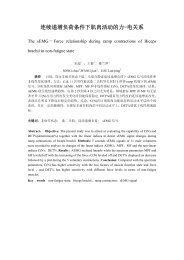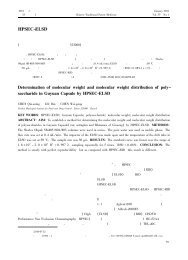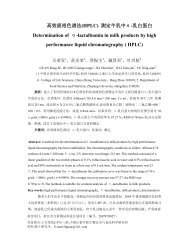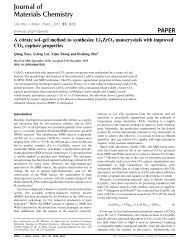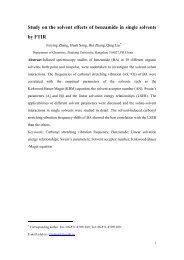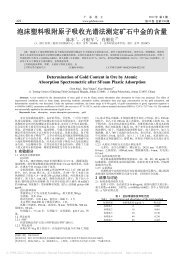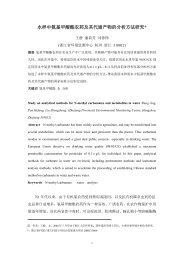Electrochemical Detector Based on Nafion Membrane for Online ...
Electrochemical Detector Based on Nafion Membrane for Online ...
Electrochemical Detector Based on Nafion Membrane for Online ...
Create successful ePaper yourself
Turn your PDF publications into a flip-book with our unique Google optimized e-Paper software.
CHINESE JOURNAL OF ANALYTICAL CHEMISTRY<br />
Volume 40, Issue 5, May 2012<br />
<strong>Online</strong> English editi<strong>on</strong> of the Chinese language journal<br />
Cite this article as: Chin J Anal Chem, 2012, 40(5), 675–680.<br />
RESEARCH PAPER<br />
<str<strong>on</strong>g>Electrochemical</str<strong>on</strong>g> <str<strong>on</strong>g>Detector</str<strong>on</strong>g> <str<strong>on</strong>g>Based</str<strong>on</strong>g> <strong>on</strong> Nafi<strong>on</strong> <strong>Membrane</strong> <strong>for</strong><br />
<strong>Online</strong> M<strong>on</strong>itoring of Column Chromatography Purificati<strong>on</strong><br />
Process<br />
TANG Yu-Hang 1 , LIU Wen-Han 1, *, TENG Yuan-Jie 1 , QIAN Jun-Qing 2 , MA Chun-An 1<br />
1<br />
College of Chemical Engineering and Material Science, Zhejiang University of Technology, Hangzhou 310014, China<br />
2<br />
College of Pharmaceutical Science, Zhejiang University of Technology, Hangzhou 310014, China<br />
Abstract: <str<strong>on</strong>g>Electrochemical</str<strong>on</strong>g> detecti<strong>on</strong> of eluent of column chromatography is c<strong>on</strong>siderably simple <strong>for</strong> m<strong>on</strong>itoring the purificati<strong>on</strong><br />
process, In this detecti<strong>on</strong> system, electrolyte is needed to decrease the resistance of soluti<strong>on</strong> during the electrochemical detecti<strong>on</strong>.<br />
However, in the case of natural medicine purificati<strong>on</strong>, it is highly challenging to added electrolyte into the purificati<strong>on</strong> process<br />
without influencing the purificati<strong>on</strong> efficiency. Herein, <strong>on</strong> the basis of Paraffin-graphite Powder electrode, an <strong>on</strong>line electrochemical<br />
detector was developed without any additi<strong>on</strong>al electrolyte. The cyclic voltammograms of myricetin in ethanol-water (80%, V/V) as<br />
mobile phase is obtained directly by using the solid acid characteristic of Nafi<strong>on</strong> N-324 membrane in the micro-gap flow cell.<br />
Peristaltic pump stimulates the chromatographic process, and then it realizes the <strong>on</strong>line detecti<strong>on</strong> of eletroactive substances in the<br />
eluent at 0.53 V. Peak area is linear with the myricetin c<strong>on</strong>centrati<strong>on</strong> in the range of 2.0 × 10 –5 –1.0 × 10 –3 M, and the linear equati<strong>on</strong> is<br />
A = 2.7227c + 0.4341, r = 0.9976. Furthermore, the detector achieves the <strong>on</strong>line detecti<strong>on</strong> of 30% AOB (antioxidant of bamboo leaves)<br />
purified by macro porous resin without any supporting electrolyte in 80% (V/V) ethanol-water at 0.62 V, and the amperometric<br />
time-current (t-i) curve during the purificati<strong>on</strong> process was presented. The result indicated that the detector is feasible <strong>for</strong> applicati<strong>on</strong>.<br />
Key Words: Natural medicine; Nafi<strong>on</strong> membrane; Antioxidant of bamboo leaves; Cyclic Voltammetry; Micro-gap flow Cell;<br />
Paraffin-graphite Powder electrode<br />
1 Introducti<strong>on</strong><br />
There is practical significance to separate and purify the<br />
active ingredients of herbal medicine. At present, the<br />
spectroscopy technology is generally selected <strong>for</strong> <strong>on</strong>line<br />
detecting liquid chromatography in most of pharmaceuticals<br />
companies. However, because of high sensitivity and simple<br />
instrument, also electrochemical detecti<strong>on</strong> can be used to<br />
detect the insensitive matter, which cannot be distinguished by<br />
spectroscopy.<br />
Flav<strong>on</strong>oids bel<strong>on</strong>g to comm<strong>on</strong> active ingredients of herbal<br />
medicine which can clear up the free radicals [13] , when the<br />
reducti<strong>on</strong> potential of free radicals is lower, the ability of<br />
antioxidant and electrochemical activity are str<strong>on</strong>ger [4,5] , thus<br />
it is suitable <strong>for</strong> the electrochemical detecti<strong>on</strong>. The crude<br />
flav<strong>on</strong>oids extracted from bamboo leaves are so complex that<br />
it needs macroporous absorpti<strong>on</strong> resin to purify. Because the<br />
carb<strong>on</strong> pasted electrode is sensitive <strong>for</strong> flav<strong>on</strong>oids [6–9] .<br />
However, the traditi<strong>on</strong>al Cyclic Voltammetry (CV) method<br />
does not fit <strong>for</strong> the <strong>on</strong>line detecti<strong>on</strong> due to large amounts of<br />
electrolytes. New electrochemical detecti<strong>on</strong> method should be<br />
developed without electrolytes or less.<br />
Nafi<strong>on</strong> is a kind of polymer which c<strong>on</strong>sists of<br />
tetrafluoroethylene and perfluoro-2-(sulf<strong>on</strong>ic acid ethoxylate)<br />
Received 1 August 2011; accepted 9 November 2011<br />
* Corresp<strong>on</strong>ding author. Email: liuwh@zjut.edu.cn<br />
This work was supported by the Science and Technology Project of Zhejiang Province/Analysis Test Foundati<strong>on</strong> of China (No. 2009F70001), and Zhejiang Province<br />
Key Scientific and Technological Innovati<strong>on</strong> Team of China (No. 2011R09002-12).<br />
Copyright © 2012, Changchun Institute of Applied Chemistry, Chinese Academy of Sciences. Published by Elsevier Limited. All rights reserved.<br />
DOI: 10.1016/S1872-2040(11)60546-X
TANG Yu-Hang et al. / Chinese Journal of Analytical Chemistry, 2012, 40(5): 675–680<br />
propylvinyl ether. Tefl<strong>on</strong> is used as framework and SO 3– M +<br />
is attached as the side chain, while M + usually is prot<strong>on</strong> or<br />
alkali metal i<strong>on</strong>, the center of acidity is single and has str<strong>on</strong>g<br />
acidity. The side chain present the surface acidity in water or<br />
organic soluti<strong>on</strong> [10] . Other research groups have designed a<br />
kind of flow cell that the noble metal is deposited <strong>on</strong> the film<br />
of Nafi<strong>on</strong> which serves as working electrode using the solid<br />
acidity character. The organic c<strong>on</strong>tents of hydroquin<strong>on</strong>e,<br />
4-butyl ferrocene, cysteine have been detected without<br />
electrolytes [11–13] .<br />
In this paper, a new flow electrochemical detector was<br />
designed using the solid acidity character of the Nafi<strong>on</strong> film to<br />
directly <strong>on</strong>line detect the flav<strong>on</strong>oids without electrolytes, the<br />
carb<strong>on</strong> pasted electrode serving as working electrode. And this<br />
method possesses sensitive dectecti<strong>on</strong> capability, simple<br />
experimental setup and reproducible results. Furthermore, it is<br />
cost-effective <strong>for</strong> <strong>on</strong>line detecting the active ingredients of<br />
herbal medicine during the separati<strong>on</strong> and purificati<strong>on</strong><br />
processi<strong>on</strong>.<br />
2 Experimental<br />
2.1 Apparatus, materials and reagents<br />
CHI660B electrochemical workstati<strong>on</strong> (Shanghai CHI<br />
Instruments Inc.), VC9808+3 1/2 figure multimeter (Shenzhen<br />
Victor Hi-tech Co., Ltd); KQ-100DB ultras<strong>on</strong>ic cleaner (Kun<br />
Shan Ultras<strong>on</strong>ic Instruments Co., Ltd), PHSJ-4A PH meter<br />
and DDS-307 c<strong>on</strong>ductivity meter (Shanghai REX instruments<br />
factory), HL-2 Peristaltic pump with fixed flow rate (Shanghai<br />
Qipuluxi instruments factory) are used in this experiment.<br />
AgCl/Ag is as reference electrode and platinum is as counter<br />
electrode (Changshu noble metal Co. Ltd.). Nafi<strong>on</strong> N-324<br />
cati<strong>on</strong> exchange film was purchased from DuP<strong>on</strong>t Company,<br />
USA, H103 macroporous absorpti<strong>on</strong> resin and graphite were<br />
purchased from Sinopharm Chemical Reagent Co., Ltd. The<br />
pureness of myricetin was 98% (Ningbo Dekang biological<br />
product Co., Ltd), and the pureness of Antioxidant of bamboo<br />
leaves was 30% (Zhejiang Anji Shengshi Biological<br />
Technology Co., Ltd). All other reagents were of analytical<br />
grade and all aqueous soluti<strong>on</strong>s were prepared with ultra pure<br />
water after deoxygenated by nitrogen.<br />
2.2 Experimental method<br />
As shown in Fig.1, the flow detecti<strong>on</strong> cell is <strong>for</strong>med by two<br />
PVC pieces (about 5.0 cm × 5.0 cm), both the reference<br />
electrode and the counter electrode are in the same<br />
compartment called counter-reference room c<strong>on</strong>taining<br />
electrolyte, which is separated by Nafi<strong>on</strong> film from the<br />
working electrode. Nafi<strong>on</strong> film needs to be dipped in H 2 SO 4<br />
soluti<strong>on</strong> (pH 2) <strong>for</strong> 8 h and washed by ultra pure water be<strong>for</strong>e<br />
using.<br />
Fig.1 Schematic view of the cell assembly<br />
W, the carb<strong>on</strong> paste working electrode; R, the reference electrode and C: the<br />
counter electrode<br />
Graphite and liquid paraffin were mixed (1 g mL –1 ) in<br />
proper proporti<strong>on</strong> to keep plasticity. The carb<strong>on</strong> paste was<br />
filled into the pore of working electrode, pressed and in close<br />
c<strong>on</strong>tact with the copper down-lead. And then the surface of<br />
electrode was grinded by filter paper until the surface of<br />
carb<strong>on</strong> paste becomes shiny. The new made electrode was<br />
dipped in anhydrous ethanol and ultras<strong>on</strong>icated <strong>for</strong> 1 min and<br />
washed by ultra pure water. All parts of instrument were fitted<br />
together by screw. 1.0 mM HCl soluti<strong>on</strong> was filled into<br />
counter-reference room, and then CV measurements were<br />
implemented by scaning the voltages over potential range<br />
from 0.2 V to 1.0 V successively until the curve was stable.<br />
Finally, the electrode was washed repeatedly with anhydrous<br />
ethanol and ultra pure water after every using. The carb<strong>on</strong><br />
paste electrode needed to be filled and treated again after <strong>on</strong>e<br />
week using.<br />
The sample liquid flowed in the inlet and out from the<br />
outlet which passed by the carb<strong>on</strong> paste electrode surface. The<br />
distance of working electrode and Nafi<strong>on</strong> film could be<br />
adjusted by the thickness of gasket. The CVs of different<br />
c<strong>on</strong>centrati<strong>on</strong> of myricetin scanned from –0.2 V to 1.2 V at a<br />
scan rate of 100 mV s –1 when the sample liquid was still. The<br />
amperometric Time-Current (t-i) curves were tested at the<br />
potential of 0.53 V with the 0.1 s sampling interval during the<br />
flow detecti<strong>on</strong>. All the electrochemical tests were per<strong>for</strong>med<br />
at the room temperature.<br />
3 Results and discussi<strong>on</strong><br />
3.1 Proporti<strong>on</strong> of liquid paraffin and graphite<br />
Liquid paraffin serves as adhesive and does not<br />
participate in c<strong>on</strong>ducting, so less in carb<strong>on</strong> paste electrode<br />
will be better. However, many organic compounds not <strong>on</strong>ly<br />
absorb <strong>on</strong> the surface of electrode, but also extracted into<br />
the electrode by liquid paraffin, which has enrichment effect,<br />
thus the proper proporti<strong>on</strong> of liquid paraffin and graphite<br />
should be selected.<br />
A series of 0.2, 0.4, 0.6, 0.8, 1.0, 1.2, 1.4 and 1.6 mL liquid
TANG Yu-Hang et al. / Chinese Journal of Analytical Chemistry, 2012, 40(5): 675–680<br />
paraffin were added into 1.0 g graphite respectively. After<br />
mixing well, the mixture was made as working electrode. The<br />
CV was tested in 2 × 10 –5 M myricetin soluti<strong>on</strong> (pH 2.01) at a<br />
scan rate of 100 mV s –1 . The relati<strong>on</strong>ship of current of<br />
oxidati<strong>on</strong> peak and the volume of liquid paraffin was recorded<br />
at 0.43 V. The electric resistance across the two sides of<br />
electrode was recorded at the same time (seen Fig.2).<br />
The results show that the resp<strong>on</strong>se current of carb<strong>on</strong> paste<br />
electrode was str<strong>on</strong>ger when more liquid paraffin was added,<br />
because the extract effect may play a major role in enhancing<br />
current. The curvature became smaller when the volume was<br />
up to 0.8 mL, which illustrated that the electr<strong>on</strong> transfer<br />
resistance was str<strong>on</strong>ger than extract effect of liquid paraffin in<br />
electrode until the resp<strong>on</strong>se reached to the str<strong>on</strong>gest at 1.0 mL.<br />
And then, the resp<strong>on</strong>se decreased and the electric resistance<br />
increased quickly until the resp<strong>on</strong>se decreased to 0 at 1.6 mL,<br />
illustrating that the liquid paraffin became a sticky film <strong>on</strong> the<br />
surface of graphite to hinder electr<strong>on</strong> transfer. There<strong>for</strong>e, it is<br />
best to mix 1.0 g graphite with 1.0 mL liquid paraffin to <strong>for</strong>m<br />
carb<strong>on</strong> paste electrode.<br />
3.2 Direct electrochemical behavior of myricetin <strong>on</strong><br />
carb<strong>on</strong> pasted electrode<br />
The CVs were scanned in ethanol soluti<strong>on</strong> (pH 2.0)<br />
c<strong>on</strong>taining 2 × 10 –5 M myricetin from –0.2 V to 1.0 V at a<br />
scan rate of 100 mV s –1 . As shown in Fig.3, there were three<br />
oxidati<strong>on</strong> peaks at 0.41 V (peak 1), 0.69 V (peak 2), 0.85 V<br />
(peak 3) respectively in the first cycle and two reducti<strong>on</strong> peaks<br />
appeared at 0.36 V (peak 4) and –0.11 V (peak 5) in the<br />
sec<strong>on</strong>d cycle.<br />
The reducti<strong>on</strong> peak 4 and the small peak 5 appeared when<br />
the CV reverse scaned after passing by peak 1. Am<strong>on</strong>g this,<br />
peak 1 relateed to the hydroxyl oxidati<strong>on</strong> of Bring [8,9] and the<br />
peak 4 and peak 5 corresp<strong>on</strong>d to the reducti<strong>on</strong> of hydroxyl of<br />
B ring. The CV of myricetin is similar with rutin, but rutin has<br />
no peak 2 [8] . Comparing with the structure of myricetin and<br />
rutin, peak 2 may corresp<strong>on</strong>d to the third positi<strong>on</strong> of hydroxy<br />
oxidati<strong>on</strong> of C ring. According to the literatures [14–16] , the free<br />
radicals are produced during the reacti<strong>on</strong> of myricetin <strong>on</strong><br />
carb<strong>on</strong> paste electrode. The mechanism shows below:<br />
The relati<strong>on</strong>ship of different terminal potential and the ratio<br />
of peak 4 oxidati<strong>on</strong> current to peak 1 reducti<strong>on</strong> current (i op /i rp )<br />
in order to prove that the step 1 is a reversible process and the<br />
step 2 is not at the beginning potential of –0.2 V. With the<br />
increasing of terminal potential from 0.6 V to 0.8 V, the i op /i rp<br />
decreased from 0.934 to 0.694 gradually. However, when the<br />
terminal potential exceeded to 0.8 V which is the positi<strong>on</strong> of<br />
peak 3, the i op /i rp decreased to 0.368 quickly. If the terminal<br />
potential further increased, the i op /i rp decreased to 0.1.<br />
There<strong>for</strong>e, peak 3 should be the sec<strong>on</strong>d process of the third<br />
mechanism, which refers to the disproporti<strong>on</strong>ati<strong>on</strong> reacti<strong>on</strong><br />
process that the free radical obtained <strong>on</strong>e electr<strong>on</strong> transfer to<br />
the structure of p-quin<strong>on</strong>e.<br />
Volume of liquid paraffin (mL)<br />
Fig.2 Effect of added liquid paraffin <strong>on</strong> the electric resistance of<br />
working electrode and the current of main oxidati<strong>on</strong> peak<br />
3.3 Effect of prot<strong>on</strong> from Nafi<strong>on</strong> to background soluti<strong>on</strong><br />
The outside three electrodes system was used to detect the<br />
CVs of liquid sample be<strong>for</strong>e and after flowing by the detecti<strong>on</strong><br />
instrument in order to observe the effect of prot<strong>on</strong> diffusing<br />
from Nafi<strong>on</strong> to background soluti<strong>on</strong>. The result showed that<br />
there was no distinct change. The c<strong>on</strong>ductivities of the liquid<br />
sample cycled in the cell at different times were tested to<br />
further c<strong>on</strong>firmati<strong>on</strong>. The c<strong>on</strong>ductivity of water used in this<br />
experiment was 1.2 S cm –1 . 10.0 mL pure water and 80%<br />
ethanol served as solvent. The results were presented in Table 1.<br />
The results indicated that the c<strong>on</strong>ductivity increased <strong>on</strong>ly<br />
1.2 S cm –1 when the 80% ethanol soluti<strong>on</strong> circulati<strong>on</strong> flowed<br />
Fig.3 Cyclic voltammograms of 2 × 10 –5 M myricetin in pH 2.0 B-R<br />
buffer (1) the first scan, the sec<strong>on</strong>d scan, scan rate 100 mV s –1
TANG Yu-Hang et al. / Chinese Journal of Analytical Chemistry, 2012, 40(5): 675–680<br />
Table 1 C<strong>on</strong>ductivity of the solvent flowing in the cell <strong>for</strong> different<br />
time<br />
Time (min) 1 2 5 10 15 30 60<br />
Water<br />
(S cm –1 )<br />
80% Ethanol<br />
(S cm –1 )<br />
1.2 1.2 1.2 1.3 1.5 1.6 2.2<br />
1.2 1.2 1.3 1.4 1.8 2.0 2.4<br />
<strong>for</strong> 1 h. Because the detecti<strong>on</strong> time of flowing is so short that<br />
the number of hydrogen i<strong>on</strong> from electrolyte room to flow<br />
room can be ignored, because it almost has no effect to<br />
background soluti<strong>on</strong>.<br />
calculated after baseline correcti<strong>on</strong> (as shown in Table 3).<br />
The relati<strong>on</strong>ship of c<strong>on</strong>centrati<strong>on</strong> and peak area is A =<br />
2.723c + 0.4341 (r = 0.9976), where A is peak area, c is<br />
c<strong>on</strong>centrati<strong>on</strong>. And the linear range is 2.0 × 10 –5 –1.0 × 10 –3 M.<br />
3.7 <str<strong>on</strong>g>Electrochemical</str<strong>on</strong>g> <strong>on</strong>line detecti<strong>on</strong> of AOB extracted by<br />
macroporous absorpti<strong>on</strong> resin<br />
70% AOB (2.0 × 10 –5 M) was filled into flow cell directly<br />
without electrolyte and the CV was detected to select the<br />
detecti<strong>on</strong> potential. There were two weak peaks at 0.37 V and<br />
0.80 V respectively and a str<strong>on</strong>g peak appeared at 0.62 V, also<br />
3.4 CVs of myricetin under the still mobile phase<br />
0.5 mL 80% ethanol soluti<strong>on</strong> c<strong>on</strong>taining myricetin (0.4 mM)<br />
was filled into the flow room of the detecti<strong>on</strong> instrument. The<br />
CV of myricetin was tested when the mobile phase was still<br />
(solid curve, in Fig.4), which was compared with the CV<br />
obtained after adding supporting electrolyte (Fig.3). The<br />
background current increased and the shape of the peak was<br />
retained. The positi<strong>on</strong> of peaks shifted. For example, the peak<br />
1 transferred from 0.43 V to 0.53 V and the peak 5<br />
disappeared.<br />
The different distances (0.5, 1.0 and 1.5 mm) between<br />
carb<strong>on</strong> paste electrode and Nafi<strong>on</strong> film were adopted to<br />
validate the acidity of Nafi<strong>on</strong> film. The highness of peak<br />
decreased quickly with the distance increased. When the<br />
distance was 1.0 mm, there was no distinct difference between<br />
the sample and background signal (dashed line, Fig.4). It<br />
illustrates that the Nafi<strong>on</strong> film has acidity character and the<br />
diffusi<strong>on</strong> of prot<strong>on</strong> can be ignored in short time.<br />
Fig.4 CVs of myricetin without electrolyte while the mobile phase<br />
is still<br />
Full line: The distant between WE and Nafi<strong>on</strong>: 0.5 mm; Dashed line: 1 mm<br />
3.5 Effect of flow rate to amperometric time-current (t-i)<br />
curves<br />
As shown in Fig.5, the amperometric t-i curves were tested<br />
at different flow rate (1.0, 1.8 and 2.6 mL min –1 ) at 0.53 V,<br />
while the c<strong>on</strong>stant flow pump simulated the situati<strong>on</strong> of liquid<br />
chromatography.<br />
The baseline was corrected and the peak area was<br />
calculated by Origin 8.1. The results are listed in Table 2.<br />
As the decreasing of flow rate of mobile phase, the shape of<br />
peak became wider, seeming like chromatography. Because<br />
the liquid sample is in the state of flowing, the curve should be<br />
affected by peristaltic pump, and the noises and relative<br />
standard deviati<strong>on</strong> increase corresp<strong>on</strong>dingly at low flow rate.<br />
3.6 Relati<strong>on</strong>ship of c<strong>on</strong>centrati<strong>on</strong> and peak area<br />
The amperometric t-i curves of different c<strong>on</strong>centrati<strong>on</strong>s of<br />
myricetin in 0.5 mL 80% ethanol were tested at 0.53 V with<br />
the flow rate of 1.8 mL s –1 . The integral peak areas were<br />
Fig.5 Time-Current resp<strong>on</strong>se up<strong>on</strong> injecti<strong>on</strong> of 0.5 mL of 0.4 mM<br />
myricetin in 80% (V/V) ethanol-water, under the volume flow<br />
rate of 1.0, 1.8, 2.6 mL min –1 respectively<br />
Table 2 Peak area of time-current curve at different flow rate<br />
Flow rate<br />
(mL s –1 )<br />
Appearance time<br />
(s)<br />
Peak area<br />
RSD<br />
(%)<br />
2.6 65, 60, 64 3.28, 3.45, 3.32 2.6<br />
1.8 93, 89, 90 3.44, 3.20, 3.32 3.6<br />
1.0 116, 117, 113 3.18, 3.38, 3.60 6.2<br />
Table 3 Integral peak area of the different c<strong>on</strong>centrati<strong>on</strong>s of<br />
myricetin<br />
C<strong>on</strong>centrati<strong>on</strong><br />
(10 –4 M )<br />
0.2 0.4 0.8 1.0 2.0 4.0 8.0 10<br />
Peak area 0.55 1.23 2.79 3.48 5.90 11.54 23.56 26.48
TANG Yu-Hang et al. / Chinese Journal of Analytical Chemistry, 2012, 40(5): 675–680<br />
two reducti<strong>on</strong> peaks overlapped. Thus the final detecti<strong>on</strong><br />
potential should be 0.62 V.<br />
This electrochemical chromatography detector was used <strong>for</strong><br />
the detecti<strong>on</strong> of AOB during the purificati<strong>on</strong> process by<br />
macroporous absorpti<strong>on</strong> resin. The sample c<strong>on</strong>tinuously<br />
flowed into the detector by peristaltic pump at 0.62 V at the<br />
flow rate of 1 mL min –1 , and the sampling interval was 0.5 s<br />
(as shown in Fig.7). The peak appearing time, maximum time<br />
and the tendency are similar with the eluti<strong>on</strong> curve of<br />
nowadays detecti<strong>on</strong> method.<br />
that of other solid electrodes.<br />
3.8 Stability and repeatability<br />
The working electrode was dipped in anhydrous ethanol,<br />
0.1 M HCl and 0.1 M NaOH successively in <strong>on</strong>e week. The<br />
peak potential and the current of myricetin soluti<strong>on</strong> (2.0 × 10 –5<br />
M, pH 2.01) were tested <strong>for</strong> three times. The mean values are<br />
listed in Table 4. The data cannot be obtained after the<br />
electrode dipping in ethanol and NaOH <strong>for</strong> 10 d, because the<br />
surface of electrode has chapped. Combining with the results<br />
in Table 4, it shows that the peak potential, current and shape<br />
have not changed in different time, because the carb<strong>on</strong> paste<br />
electrode has good stability.<br />
However, the most stable potentials of carb<strong>on</strong> paste<br />
electrode are changed at different pH. The increasing of<br />
positive potential would make the carb<strong>on</strong> <strong>on</strong> the surface of<br />
electrode loosen and detached under the c<strong>on</strong>diti<strong>on</strong>s of pH 2.01,<br />
3.13, 4.01, 5.02, 6.30 and 7.00, so the most stable potential is<br />
1.37, 1.45, 1.50, 1.55, 1.65 and 1.78 V corresp<strong>on</strong>dingly. The<br />
positive potential range of carb<strong>on</strong> paste electrode is wider than<br />
Fig.6 CV of AOB in the cell<br />
Fig.7<br />
Time-Current resp<strong>on</strong>se of spent regenerant during the<br />
absorpti<strong>on</strong> and purificati<strong>on</strong> process of AOB<br />
Table 4 Stability of carb<strong>on</strong> paste electrode in different media<br />
1 d 2 d 4 d 8 d 10 d<br />
Pp Pc Pp Pc Pp Pc Pp Pc Pp Pc<br />
Alcohol (V, A) 0.43 6.5 0.45 6.3 0.45 5.9 0.46 5.3 - -<br />
Acid (V, A) 0.43 5.8 0.43 5.7 0.43 5.4 0.44 5.0 0.43 5.3<br />
Alkali (V, A) 0.43 5.9 0.43 5.4 0.45 5.2 0.50 4.3 - -<br />
Notice: Pp, Peak potentia ; Pc, Peak current.<br />
References<br />
[1] Zhang J J, Cao S W, Yu Y Y. Chinese. J. Anal. Chem., 2009,<br />
37(12): 1810–1814<br />
[2] Jovanovic S V, Steenken S, Hara Y, Simic M G. Journal of the<br />
Chemical Society, Perkin Transacti<strong>on</strong>s 2, 1996, (11): 2497–2504<br />
[3] Pannala A S, Chan T S, O'Brien P J, Rice-Evans C J.<br />
Biochemical and Biophysical Research Communicati<strong>on</strong>s,<br />
2001, 282(5): 1161–1168<br />
[4] Jovanovic S V, Steenken S, Tosic M, Marjanovic B, Simic M<br />
G. Journal of the American Chemical Society, 1994, 116(11):<br />
4846–4851<br />
[5] Jovanovic S V, Hara Y, Steenken S, Simic M G. Journal of the<br />
American Chemical Society, 1995, 117(39): 9881–9888<br />
[6] Xu X R, He J B, Cheng P. Food Science, 2010, 31(7): 6–9<br />
[7] Yu C L, He J B. Chemistry & Bioengineering, 2006, 23(5):<br />
55–57<br />
[8] Ghica M E, Brett A M O. Electroanalysis, 2005, 17(4):<br />
313–318<br />
[9] Brett A M O, Ghica M E.. Electroanalysis, 2003, 15(22):<br />
1745–1750<br />
[10] Xu B Q, Qiu X Q, Zhu Q M. Chemistry <strong>Online</strong>, 1999, 62(13):<br />
90091 (in Chinese)<br />
[11] T<strong>on</strong>iolo R, Comisso N, Schiav<strong>on</strong> G, B<strong>on</strong>tempelli G. Anal.<br />
Chem., 2004, 76(7): 2133~2137<br />
[12] Kaaret T W, Evans D H. Anal. Chem., 1988, 60(7):657–662<br />
[13] Prasad K S, Muthuraman G, Zen J M. Electroanalysis, 2008,<br />
20(11): 1167–1174<br />
[14] Krol E S, Bolt<strong>on</strong> J L. Chemico-Biological Interacti<strong>on</strong>s, 1997,<br />
104(1): 11–27
TANG Yu-Hang et al. / Chinese Journal of Analytical Chemistry, 2012, 40(5): 675–680<br />
[15] Galati G, Moridani M Y, Chan T S, O’Brien P J. Free Radical<br />
Biology & Medicine, 2001, 30(4): 370–382<br />
[16] Wei Y L, Wang Y Z, Hu S S. Chem. J. Chinese Universities,<br />
2004, 25(1): 148–150




